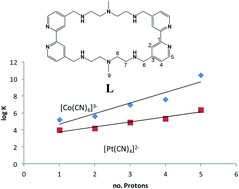Protonation, coordination chemistry, cyanometallate “supercomplex” formation and fluorescence chemosensing properties of a bis(2,2′-bipyridino)cyclophane receptor†
Abstract
A new polyazamacrocycle (L) containing two 2,2′-bipyridino (bpy) units, where the heteroaromatic nitrogen atoms point outwards from the macrocyclic cavity, was synthesized and characterized by elemental analysis, ESI-MS, 1H and 13C NMR, FTIR and TGA. Five protonation constants involving aliphatic nitrogens with log K in the range 9.39–3.07 were determined by potentiometry and NMR and a sixth protonation (log K = 2.2) involving a bipyridine moiety could be detected by UV-Vis and NMR titrations. The interaction of L with the cyanometallate anions [Pt(CN)4]2− and [Co(CN)6]3− was studied by potentiometry yielding respectively log K values in the ranges 4.0–6.4 and 5.2–10.5, covering protonation degrees from 1 to 5. Studies on L with [Ru(CN)6]4− led to early precipitation preventing potentiometry, but crystals of [H4L][Ru(CN)6]·10H2O and also of [H2L](ClO4)2·4H2O suitable for X-ray diffraction could be obtained and the crystalline structures are described. The interaction of L with Zn2+ was investigated by potentiometry and UV-Vis showing the formation of mono- and dinuclear complexes involving the bipyridines. The macrocycle was used as a bridging ligand for the successful synthesis of a new dinuclear [(Ru(bpy)2)2(L)](PF6)4·4HPF6 complex that was fully characterized. The protonation (log K in the range 9.9–1.6) and coordination features of this compound towards Cu2+ and Zn2+ were explored by UV-Vis absorption and emission spectroscopies.


 Please wait while we load your content...
Please wait while we load your content...